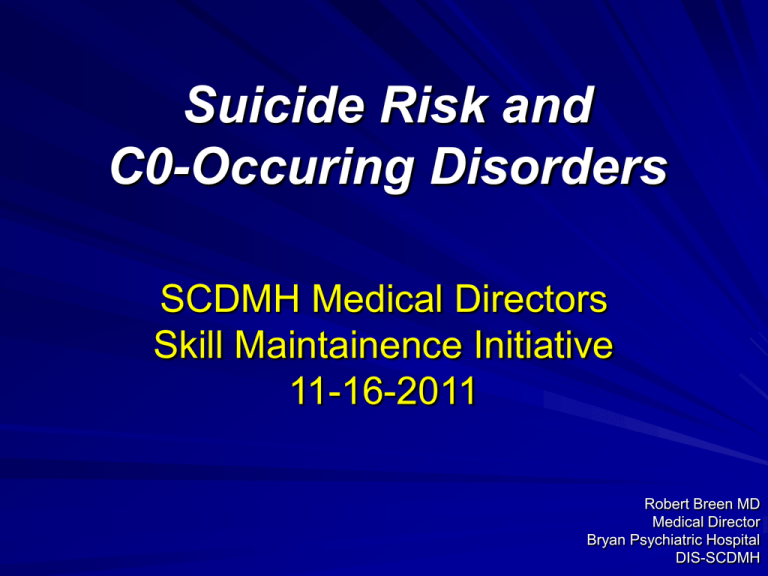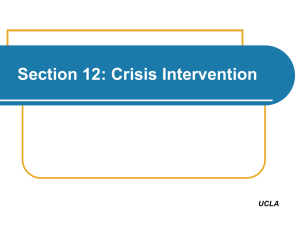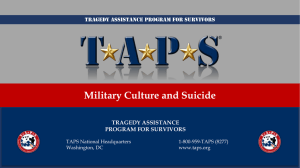
Suicide Risk and
C0-Occuring Disorders
SCDMH Medical Directors
Skill Maintainence Initiative
11-16-2011
Robert Breen MD
Medical Director
Bryan Psychiatric Hospital
DIS-SCDMH
Suicide Risk and Co-Occuring Disorders
Examine how substance
abuse affects suicide risk
2. Examine suicide risk in
different components of the
four quadrant model
3. Describe available suicide
risk management options
for persons needing
substance abuse treatment
1.
Suicide Rate in SC 2001-2008
Year
2001
2002
2003
2004
2005
2006
2007
2008
Number
473
466
496
483
503
533
529
542
Rate
11.6
12.2
11.7
12.0
SCVDRS and CDC
Jamison
1999
Suicide Risk and Substance Abuse
How does Substance Abuse
Interact with
Suicide Risk
Suicide Risk
Compared with the general
population, individuals treated
for alcohol abuse or
dependence are at about 10
times greater risk for suicide.
People who inject drugs are at
about 14 times greater risk for
suicide (Wilcox, et al., 2004).
Suicide Prevention Efforts for Individuals with Serious Mental Illness
National Association of State Mental Health Program Directors
Medical Directors Council
March 2008
Suicide Risk and Substance Abuse
Suicide Risk and Substance Abuse
Alcohol and drugs can:
– Deplete serotonin, dopamine and other
neurotransmitters linked to suicide
Suicide Risk and Substance Abuse
Drugs to overdose by:
– Opiates
– Cocaine
– Benzodiazepines
– Inhalants
Suicide Risk
Alcohol’s acute effects include
disinhibition, intense focus on the
current situation with little
appreciation for consequences,
and promoting depressed mood, all
of which may increase risk for
suicidal behavior (Hufford, 2001).
Other central nervous system
depressants may act similarly.
Addressing Suicidal Thoughts And Behaviors in Substance Abuse Treatment
SAMHSA TIP 50 2009
Suicide Risk
Depression is a common cooccurring diagnosis among
people who abuse substances
that confers risk for suicidal
behavior
Other mental disorders are also
implicated.
Addressing Suicidal Thoughts And Behaviors in Substance Abuse Treatment
SAMHSA TIP 50 2009
Suicide Risk
Intense, short-lived depression is
prevalent among treatment-seeking
people who abuse cocaine,
methamphetamines, and alcohol,
among other groups (Brown et al.,
1995; Cornelius, Salloum, Day, Thase,
& Mann, 1996; Husband et al., 1996).
Even transient depression is a potent
risk factor for suicidal behavior among
people with substance use disorders.
Addressing Suicidal Thoughts And Behaviors in Substance Abuse Treatment
SAMHSA TIP 50 2009
Suicide Risk and Substance Abuse
Alcohol can increase suicide risk by:
– Makes it easier to go ahead with an
attempt
– Makes attempts more lethal
– Interferes with effective problem solving
skills
Characteristics of the Person with Alcohol
Problems who Suicides
Started drinking at young age
Consumed alcohol over long period of time
Drank heavily
Poor physical health
Depressed
Disturbed and chaotic lives
Recent interpersonal loss
Performed poorly at work
Family history of alcoholism
Adapted from World Health Organization 2000
Suicide Risk and Substance Abuse
Studies in Denmark and the USSR
demonstrated that suicide rates
decreased with more restrictive
alcohol policies
While in the US increases in alcohol
consumption correlate with increase
in suicide rates
Risk Clusters
1. Mental illness + Alcohol problems
2. Mental illness + recent Crisis
3. Mental illness only
4. Depression + Financial problems
(little treatment)
5. Alcohol problems + Stressors
(some depression)
6. Depression + MEDICAL PROBLEMS (little treatment)
7. Legal problems + recent Crisis
(interpersonal problems)
8. Interpersonal problems + recent Crisis + Alcohol
9. Alcohol Intoxication at the time of death (dependence)
Suicide Categories by Patterns of Known Risk Factors:
A Latent Class Analysis
Logan, Hall, Karch.
Arch Gen Psychiatry 2011;68(9): 935-941
National Suicide Prevention Hotline
Core Principles
SUICIDE
DESIRE
SUCIDE
CAPABILITY
SUICIDAL
INTENT
Ideation
Attempt history
Attempt
in progress
Psychological
pain
Violence history
Hopelessness
Available means
Perceived burden
Feeling trapped
Intolerably alone
Plan
method known
Planning for the future
Engagement
Preparatory
behaviors
Psych symptoms
Agitation/rage
Immediate Supports
Social supports
Intoxicated
Substance abuse
BUFFERS/
CONECTEDNESS
Ambivalence
Core values beliefs
Expressed
intent to die
Sense of purpose
Suicide and Life-Threatening Behavior 37(3) June 2007 353
The American Association of Suicidology
The CTS Suicide Equation
Desire X Intent
----------------------------Buffers
X Capability
The Suicide Equation
Pain X Hopelessness
----------------------------Connectedness
X CAPABILITY
Suicide Risk and Substance Abuse
Suicide and Substance
Abuse in
South Carolina
2003 Suicide in South Carolina
Adolescent male with interpersonal
problem, probable substance abuse but
possibly “not depressed” and not treated
Adult male with intimate partner problem,
probable mental illness, possibly in
treatment, possible substance abuse
Elderly male with physical problems,
depressed, but likely not acknowledging
depression and not in treatment
2003 Suicide in South Carolina
Age 1-17
50%
38%
25%
25%
Interpersonal problem
Substance abuse problem
Depressed mood
Mental health problem
12.5% Current mental health tx.
SC-DHEC- SCDVRS
2003 Suicide in South Carolina
Age 24-54
58.7%
39.8%
37.8%
18.9%
18.1%
Depressed mood
Mental health problem
Problem with partner
Alcohol problem
Physical health problem
37.4% Current mental health tx.
SC-DHEC- SCDVRS
2003 Suicide in South Carolina
Age 55-older
63.3% Physical health problem
62.6% Depressed mood
31.7% Mental health problem
18.1% Current mental health tx.
SC-DHEC- SCDVRS
Suicide Risk In the Elderly
ADDITIONAL RISK FACTORS
FOR SUICIDE IN OLDER PERSONS
Heavy alcohol use
Presence of mental disorders in addition to depression
Presence of a serious physical illness
Social isolation, particularly after the death of a spouse or
close friend
Access to firearms
JAMA Patient Page
Vol. 291 No. 9, March 3, 2004
Suicide Risk and Substance Abuse
Suicide Risk in the
South Carolina
Public Sector
Risk clusters from SCDMH reports
Cluster 1
White, male
Mood disorder
Lost wife or girl friend
Lost income:
Cannot keep a job
Disability assistance turned down
Suffering from chronic pain
Alcohol/ substance abuse
Young adult male about to go to jail (again)
Methods: Gunshot , Hanging
Risk clusters from SCDMH reports
Cluster 2
Schizophrenia (CUS)
Male or female
Occurs without warning
With or without depression
Methods: Struck by train
Leaping in front of moving trucks/cars
Leaping from overpass onto roadway
Risk clusters from SCDMH reports
Cluster 3
Female
Mood Disorder, especially Major Depression
Substance abuse, addiction to Rx medications
Personal Health Issues (e.g., cancer)
Unresolved early-age trauma?
Method: Overdose
Risk clusters from SCDMH reports
Cluster 4
Either sex, grieving over lost/dead friend or child
Major Depression
Alcohol is prominent coping mechanism
Believes she/he can be reunited with the lost
one in death (this may be a covert belief)
Method: Gunshot, often near the grave of the
lost one
Suicide Risk
Suicide risk often goes undetected, even
though individuals at heightened risk for
suicide frequently seek and receive medical
care in primary care settings.
Screening of persons with depression and
substance abuse in primary care settings can
identify individuals at elevated risk for
suicide and expedite their referral for
definitive evaluation and treatment.
Recommendation: The SMHA (DMH), in
collaboration with the SHA, should require
screening for suicide risk at all primary care
appointments for those individuals who
exhibit risk factors such as depression or
substance abuse.
Suicide Prevention Efforts for Individuals with Serious Mental Illness
National Association of State Mental Health Program Directors
Medical Directors Council
March 2008
Suicide Risk and Substance Abuse
Suicide Risk Assessment
Suicide Risk
The risk for suicidal behavior may increase
at any point in treatment
Suicide risk may increase at transition points in care
Suicide risk may increase when
a client’s treatment is terminated administratively
In clients with a history of suicidal thoughts or attempts
suicide risk may increase with relapse
In clients with a history of suicidal thoughts or attempts
suicide risk may increase when a client implies
that the worst might happen if they relapse
In clients with a history of suicidal thoughts or attempts
suicide risk may increase when they are
experiencing acute stressful life events
Addressing Suicidal Thoughts And Behaviors in Substance Abuse Treatment
SAMHSA TIP 50 2009
Suicide Risk and Co-Occurring Disorders
The Four Quadrant Model
Addressing Suicidal Thoughts And Behaviors in Substance Abuse Treatment
SAMHSA TIP 50 2009
Suicide Risk
Quadrant I folks should
be low risk, as suicidal
ideation with significant
risk factors would raise
the MI severity level
Suicide Risk
Quadrant’s II and III
would have elevated
suicide risk and should
be screened for suicide
risk factors when life
stressors/losses occur
Suicide Risk
Quadrant IV folks would
present significant risk
and monitoring for
changes in suicide risk
should be an ongoing
concern for case
management and at
psychiatric assessment.
Crisis Suicide Assessment
Safety Plan
Must be willing to engage in treatment!
Get patient’s commitment to follow-up assessment!
Must not have impulsive access to method!
Must have responsible others to monitor for worsening
who willingly collaborate on safety plan!
Must agree to not use alcohol and/or street drugs!
Ask about firearms!
Suicide Risk and
Substance Abuse
The End










